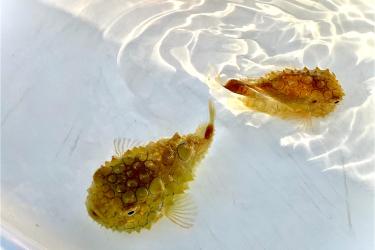Our team flew to Adak Island, Alaska on Thursday, June 23 and we were welcomed with clear skies and beaming sunshine—a rare sight in the Aleutian Islands since this area can be plagued by fog during the summer. We loaded our gear onto the Tiglax, a 120-ft research vessel operated by the Alaska Maritime National Wildlife Refuge. The ship is quite comfortable, especially given our moderately-sized crew of eight people.
We have four Steller sea lion, National Marine Fisheries Service (NMFS) biologists on board, they are: Tom Gelatt (the Alaska Ecosystem Program Leader), Brian Fadely, Van Helker and me. Killer whale biologist, Paul Wade, his volunteer Kristen Campbell, and NMFS fish biologists Susanne McDermott and Mike Levine also joined us.

Hexacopter (or drone) researchers use to survey Steller sea lions.
Since sailing on Thursday evening, we have been lucky with calm seas and relatively low winds. Unfortunately, this is the perfect formula for fog, a marine mammal biologist's nemesis because fog obstructs our view. Despite the fog, we have been able to survey all of the sea lion sites along the 300 miles of the Island chain we have passed so far. Most of the sites are quite small and we have surveyed them from the ship or a skiff offshore.

Killer whale spotted swimming along the Aleutian Island chain during first week of survey.
Fortunately, the weather cooperated enough to allow Van Helker and me to fly the hexacopter (unoccupied aircraft vehicle, or drone) and survey two of our larger sites. These sites are rookeries, which are breeding and pupping areas. Aerial images offer an incredible perspective to easily collect accurate and complete sea lion counts.
We had low fog at another rookery site which meant we could not fly above that location due to safety restrictions. We had to resort to more tedious measures for collecting counts—hiding in the grass and counting with binoculars. Luckily, the site is at the base of a 40-foot bank giving us a favorable, vertical perspective and allowing us to obtain accurate counts of adults, juveniles, and newborn sea lions or pups.
The whale survey team has been getting some observation time in between the fog banks, which can limit visibility to only a few hundred feet. So far, they have documented three groups of killer whales. On June 24, we encountered a group of four resident (fish-eating) whales. Over the weekend, we saw a group of four transient (marine-mammal eating) whales in the Rat Islands. The Rat Islands are a killer whale hot spot.

Fish biologist Mike Levine shows underwater camera.
Transient killer whales prey on marine mammals, including Steller sea lions. Resident killer whales are fish-eating and may have a diet that is similar to Steller sea lions, including the Stellers’ main prey in the western Aleutians, Atka mackerel. Paul and Kristen are attempting to attach satellite-linked transmitters to either type of killer whale to collect information on the animal's movements and dive patterns. They made two attempts at tagging but were unsuccessful.
Aside from killer whales, they also spotted six Dahl’s porpoise, three adult male sperm whales, and one minke whale.
The fish biologists have been using every spare moment to lower their prototype underwater camera system to capture video at varying depth zones from 25, 50, 75, and 100 meters. They have almost completed three survey efforts and towed the camera ten times. This is valuable footage that will provide information about Steller sea lions’ feeding grounds.
This unique surveying method allows scientists to sample areas that cannot be reached with traditional methods, like trawling, due to the rugged seafloor. In just a few days, they’ve already explored different types of bottom substrate, like sand and rocky bottom, and have seen numerous fish species.
There is much more to come so please stay tuned! We are now going to finish up surveying around the Rat Islands and continue west to Buldir and the Near Islands in the coming week. Wish us luck, low winds, little fog, and dry skies!
Meet the Blogger

Katie Sweeney
Katie Sweeney is NOAA fisheries biologist participating in the 2016 Aleutian Island Research Survey. During the three week survey, she will post about what the team is doing and seeing. Katie has worked at the Alaska Fisheries Science Center's Marine Mammal Laboratory since 2007. She primarily works on Steller sea lion population abundance and monitoring. She is also involved in life history and demographic studies of pinniped species. During the trip, the team will be using a hexacopter, an unoccupied aircraft system, to capture images of sea lions that are critical for collecting accurate counts and for identifying permanently marked animals. Katie is one of the group's FAA-certified hexacopter pilots.
Katie thinks the best part of her job is traveling to Alaska during the summers to participate in field work on abundance and life history projects. She received her B.S. in Aquatic and Fisheries Sciences from the University of Washington in 2006 and later earned her Master’s Degree from Duke University in 2012. In her spare time, she enjoys backpacking, diving, and traveling as much as possible.


